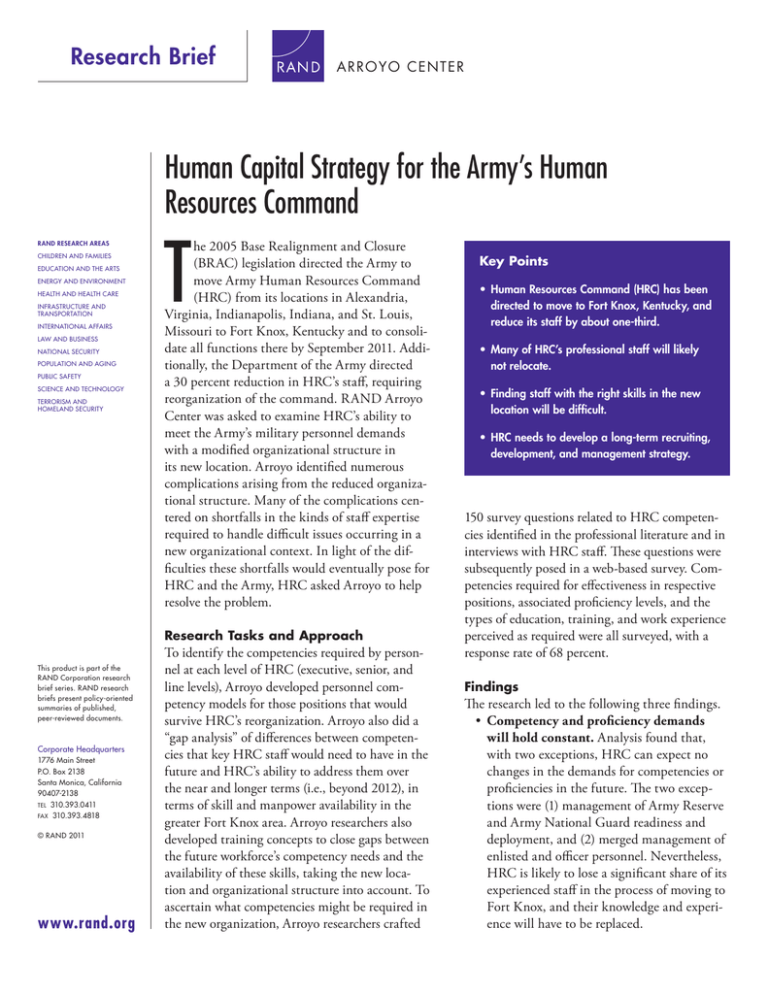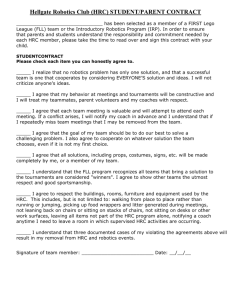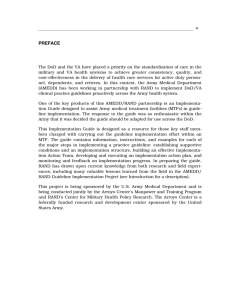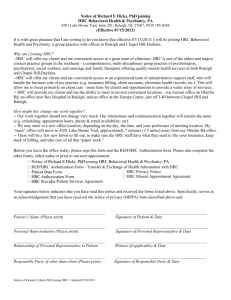T Human Capital Strategy for the Army’s Human Resources Command
advertisement

Research Brief ARROYO CENTER Human Capital Strategy for the Army’s Human Resources Command RAND Research areas Children and Families Education and the Arts Energy and Environment Health and Health Care Infrastructure and Transportation International Affairs Law and Business National Security Population and Aging Public Safety Science and Technology Terrorism and Homeland Security T he 2005 Base Realignment and Closure (BRAC) legislation directed the Army to move Army Human Resources Command (HRC) from its locations in Alexandria, Virginia, Indianapolis, Indiana, and St. Louis, Missouri to Fort Knox, Kentucky and to consolidate all functions there by September 2011. Additionally, the Department of the Army directed a 30 percent reduction in HRC’s staff, requiring reorganization of the command. RAND Arroyo Center was asked to examine HRC’s ability to meet the Army’s military personnel demands with a modified organizational structure in its new location. Arroyo identified numerous complications arising from the reduced organizational structure. Many of the complications centered on shortfalls in the kinds of staff expertise required to handle difficult issues occurring in a new organizational context. In light of the difficulties these shortfalls would eventually pose for HRC and the Army, HRC asked Arroyo to help resolve the problem. Research Tasks and Approach This product is part of the RAND Corporation research brief series. RAND research briefs present policy-oriented summaries of published, peer-reviewed documents. Corporate Headquarters 1776 Main Street P.O. Box 2138 Santa Monica, California 90407-2138 Tel 310.393.0411 Fax 310.393.4818 © RAND 2011 www.rand.org To identify the competencies required by personnel at each level of HRC (executive, senior, and line levels), Arroyo developed personnel competency models for those positions that would survive HRC’s reorganization. Arroyo also did a “gap analysis” of differences between competencies that key HRC staff would need to have in the future and HRC’s ability to address them over the near and longer terms (i.e., beyond 2012), in terms of skill and manpower availability in the greater Fort Knox area. Arroyo researchers also developed training concepts to close gaps between the future workforce’s competency needs and the availability of these skills, taking the new location and organizational structure into account. To ascertain what competencies might be required in the new organization, Arroyo researchers crafted Key Points •Human Resources Command (HRC) has been directed to move to Fort Knox, Kentucky, and reduce its staff by about one-third. • Many of HRC’s professional staff will likely not relocate. • Finding staff with the right skills in the new location will be difficult. •HRC needs to develop a long-term recruiting, development, and management strategy. 150 survey questions related to HRC competencies identified in the professional literature and in interviews with HRC staff. These questions were subsequently posed in a web-based survey. Competencies required for effectiveness in respective positions, associated proficiency levels, and the types of education, training, and work experience perceived as required were all surveyed, with a response rate of 68 percent. Findings The research led to the following three findings. • Competency and proficiency demands will hold constant. Analysis found that, with two exceptions, HRC can expect no changes in the demands for competencies or proficiencies in the future. The two exceptions were (1) management of Army Reserve and Army National Guard readiness and deployment, and (2) merged management of enlisted and officer personnel. Nevertheless, HRC is likely to lose a significant share of its experienced staff in the process of moving to Fort Knox, and their knowledge and experience will have to be replaced. • It will be difficult to meet workforce demands in the Fort Knox area. Gap analysis subsequently showed that it will be difficult for HRC to meet its near-term (2010– 2012) workforce quantity and quality demands in the Fort Knox area, both because the demands will be high and because the supply in some areas will be low. HRC’s estimates indicate that fewer than 40 percent of current incumbents will likely move to Kentucky. Furthermore, 40 percent of the current workforce is also eligible for retirement by 2010, and an additional 30 percent is eligible for early retirement by the same date. Low retention’s effects on meeting workforce demand are compounded by the finding that the Fort Knox area is not a promising recruiting ground. Extensive field and archival research into the Fort Knox area labor market indicated that industries located there struggle despite extensive recruiting plans and actions and that civil service hiring rules make the problem more difficult for the Army. • Ensuring a fully staffed and competent HRC workforce beyond 2010 will require long-term recruiting, development, and management strategies. These efforts will need to be greater than those initially envisioned by HRC. HRC will need different near- and long-term approaches, including prioritized retention strategies, national searches, and targeted recruiting at Fort Knox. The overall process should emphasize first narrowing quantitative and qualitative gaps in the workforce in the near term (between 2010 and 2012), and then closing them by 2013 and beyond; this occurs as the workforce stabilizes and more and more workers gain required competencies and associated proficiency levels. Associated actions must begin presently, however, and be in consonance with a clear, well-resourced institutional human capital strategy. This strategy, with modifications as appropriate along the way, should carry HRC from the present through 2013 and beyond. Recommendations The findings led Arroyo researchers to make four recommendations. First, HRC should formulate an institutional human capital strategy to provide a coherent framework to guide marketing, hiring, training, performance evaluation, and other activities designed to create, develop, and retain a new workforce. Development and implementation of this strategy should begin now. Designation of an executive-level staff agent to lead the development of its human capital strategy is essential. HRC would further profit by designating a Chief of Training and Staff Development at this crucial time, to integrate personnel competency requirements into training activities across the organization and to work with HRC supervisors and employees to determine staff development needs and strategies. Second, HRC should use personnel competency modeling results from Arroyo research to determine competency and proficiency requirements. Setting down these requirements will aid HRC in developing training curricula, defining specific job requirements, and enhancing the ability of supervisors to evaluate worker performance and make recommendations for staff development. Third, HRC’s plan for a new training framework should rest on four concepts. Specifically, HRC must (1) narrow quantitative and qualitative gaps over the short term (from 2010 to 2012), (2) close those gaps over the longer term (beyond 2012), (3) use outcome-driven, competency-based recruiting, training, and evaluation, and (4) conduct continuous training, evaluation, and upgrading of skills to build long-term workforce capacity and stability. Fourth, HRC should partner with Kentucky’s educational institutions to produce the necessary competencies. With adjustments by HRC as appropriate, the approach should provide a basis for operational specifications of competencies and proficiency levels, as well as means to attain them. ■ This research brief describes work done by the RAND Arroyo Center and documented in Supporting the U.S. Army Human Resources Command’s Human Capital Strategic Planning, by Ralph Masi, Anny Wong, John E. Boon, Jr., Peter Schirmer, and Jerry M. Sollinger, MG-828-A, 2009 (available at http://www.rand.org/pubs/ monographs/MG828.html). This research brief was written by Jerry Sollinger. The RAND Corporation is a nonprofit institution that helps improve policy and decisionmaking through research and analysis. RAND’s publications do not necessarily reflect the opinions of its research clients and sponsors. R® is a registered trademark. RAND Offices Santa Monica, CA • Washington, DC • Pittsburgh, PA • New Orleans, LA/Jackson, MS • Boston, MA • Doha, QA • Abu Dhabi, AE • Cambridge, UK • Brussels, BE RB-9621-A (2011) CHILDREN AND FAMILIES EDUCATION AND THE ARTS The RAND Corporation is a nonprofit institution that helps improve policy and decisionmaking through research and analysis. ENERGY AND ENVIRONMENT HEALTH AND HEALTH CARE INFRASTRUCTURE AND TRANSPORTATION This electronic document was made available from www.rand.org as a public service of the RAND Corporation. INTERNATIONAL AFFAIRS LAW AND BUSINESS NATIONAL SECURITY POPULATION AND AGING PUBLIC SAFETY SCIENCE AND TECHNOLOGY TERRORISM AND HOMELAND SECURITY Support RAND Browse Reports & Bookstore Make a charitable contribution For More Information Visit RAND at www.rand.org Explore the RAND Arroyo Center­­­ View document details Research Brief This product is part of the RAND Corporation research brief series. RAND research briefs present policy-oriented summaries of individual published, peer-reviewed documents or of a body of published work. Limited Electronic Distribution Rights This document and trademark(s) contained herein are protected by law as indicated in a notice appearing later in this work. This electronic representation of RAND intellectual property is provided for noncommercial use only. Unauthorized posting of RAND electronic documents to a non-RAND website is prohibited. RAND electronic documents are protected under copyright law. Permission is required from RAND to reproduce, or reuse in another form, any of our research documents for commercial use. For information on reprint and linking permissions, please see RAND Permissions.





